文章目录
1. 简介
https://blog.csdn.net/m0_60139894/article/details/121951846
- Spring:春天----->给软件行业带来了春天!
- 2002,首次推出了Spring框架的雏形:interface21框架!
- Spring框架即以interface21框架为基础,经过重新设计,并不断丰富其内涵,于2004年3月24日,发布了1.0正式
版。 - Rod Johnson, Spring Framework创始人,著名作者。很难想象Rod Johnson的学历,真的让好多人大吃一惊,他是悉尼大学的博士,然而他的专业不是计算机,而是音乐学。
- spring理念:使现有的技术更加容易使用,本身是一个大杂烩,整合了现有的技术框架!
官网:https://spring.io/projects/spring-framework
官方下载地址:http:l/repo.spring.io/release/org/springframework/spring
GitHub地址:https://github.com/spring-projects/spring-framework
maven地址,在https://mvnrepository.com/搜索使用Spring Web MVC
<!-- https://mvnrepository.com/artifact/org.springframework/spring-webmvc -->
<dependency>
<groupId>org.springframework</groupId>
<artifactId>spring-webmvc</artifactId>
<version>6.0.8</version>
</dependency>
<!-- https://mvnrepository.com/artifact/org.springframework/spring-webmvc -->
<dependency>
<groupId>org.springframework</groupId>
<artifactId>spring-jdbc</artifactId>
<version>6.0.8</version>
</dependency>
1.1 优点
- Spring是一个开源的免费的框架(容器)!
- Spring是一个轻量级的、非入侵式的框架!
- 控制反转 (1OC),面向切面编程 (AOP)!
- 支持事务的处理,对框架整合的支持!
总结一句话:Spring就是一个轻量级的控制反转 (IOC) 和面向切面编程(AOP)的框架!
1.2 组成
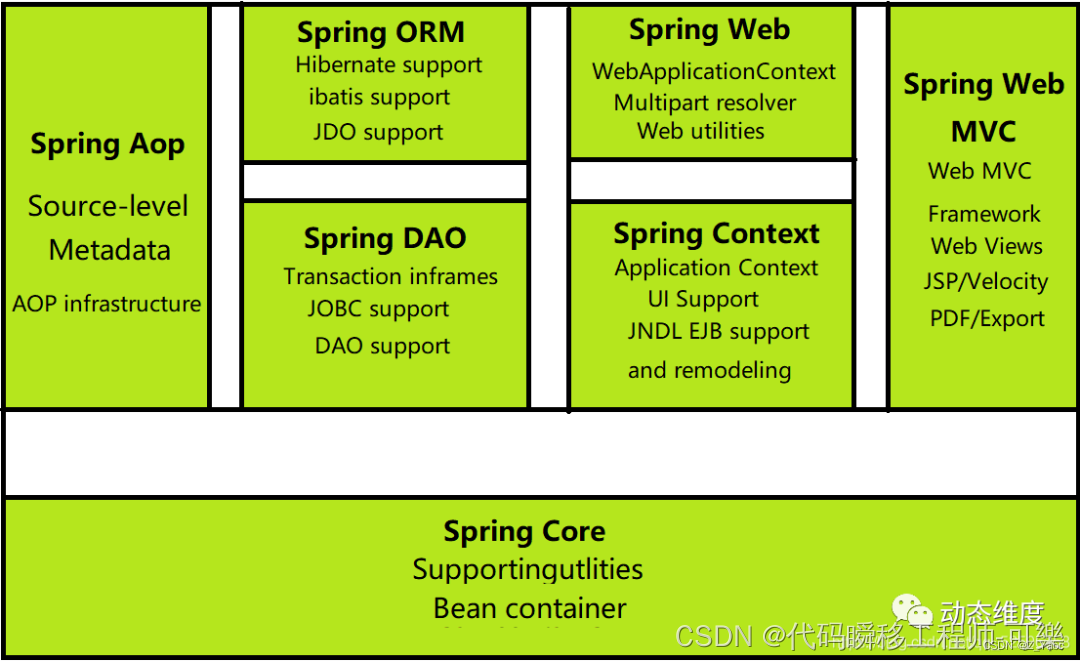
1.3 拓展
在spring官网有这个介绍:现代化的java开发!其实就是基于Spring的开发!
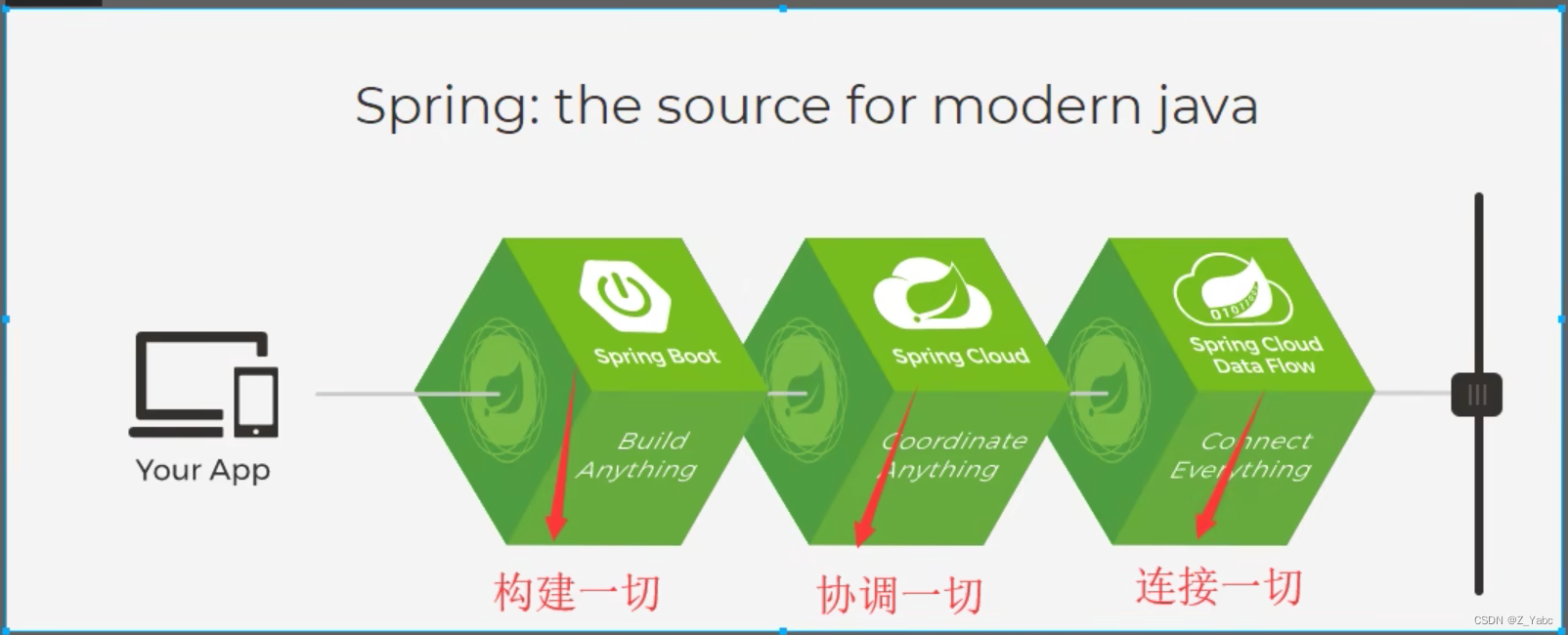
- Spring Boot
- 一个快速开发的脚手架。
- 基于SpringBoot可以快速开发单个微服务。
- 约定大于配置
- Spring Cloud
- SpringCloud是基于SpringBoot实现的。
因为现在大多数公司都在使用SpringBoot进行快速开发,学习SpringBoot的前提,需要完全掌握Spring及SpringMVC!Spring是一个承上启下的作用。
弊端:发张了太久之后,违背了原来的理念!配置十分繁琐,人称:“配置地狱”。
2. IOC理论推导
原来实现一个业务:
- UserDao 接口
- UserDaoImpl 实现类
- UserService 业务接口
- UserServiceImpl 业务实现类
在我们之前的业务中,用户的需求可能会影响我们原来的代码,我们需要根据用户的需求去修改原代码!如果程序
代码量十分大,修改一次的成本代价十分昂贵!
我们使用一个Set接口实现.
- 之前,程序是主动创建对象!控制权在程序员手上!
- 使用set注入后,程序不再具有主动性,而是变成了被动的接受对象!
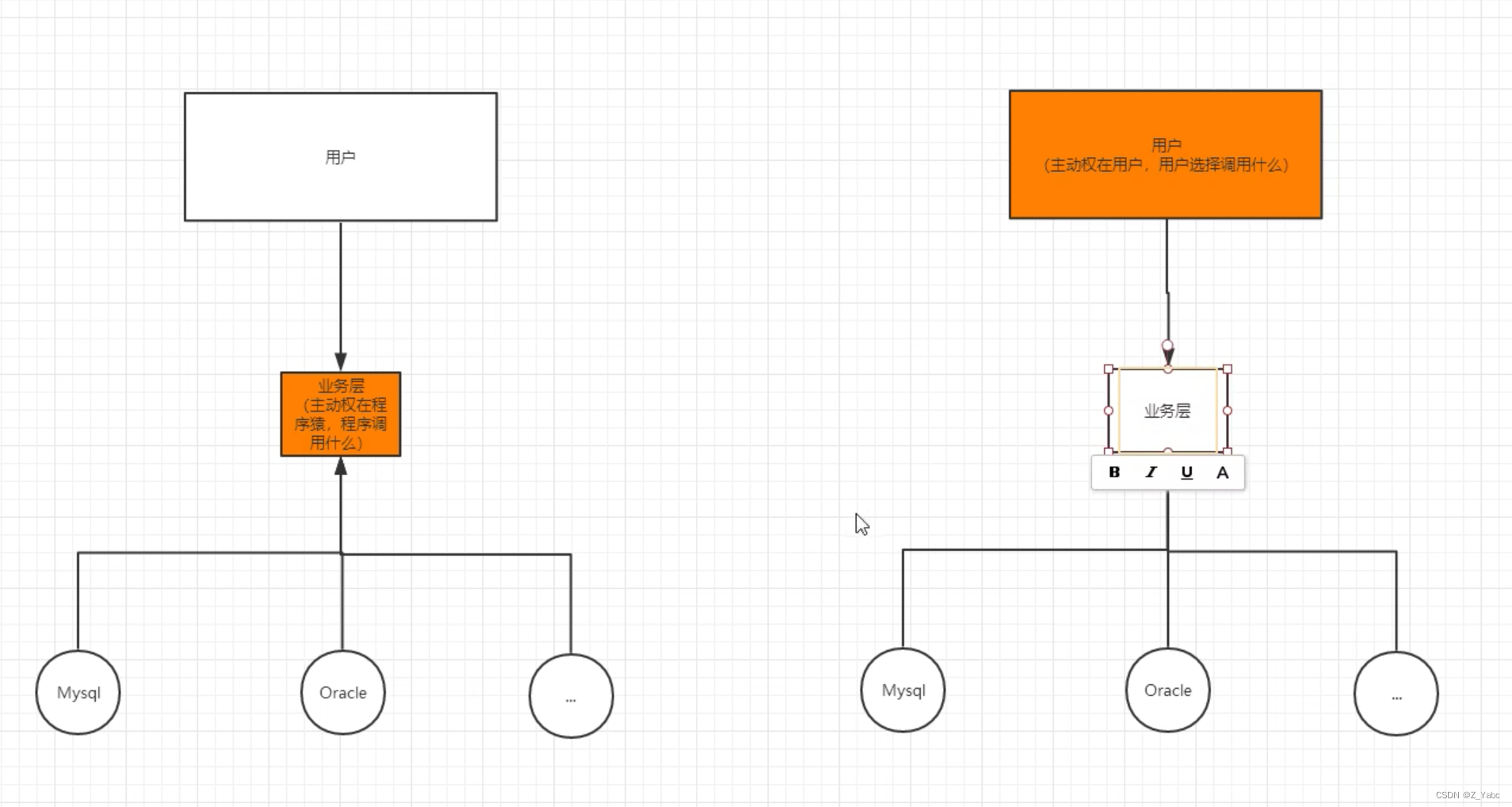
这种思想,从本质上解决了问题,我们程序员不用再去管理对象的创建了。系统的耦合性大大降低,可以更加专注在业务的实现上!这是IOC的原型!
1.2 IoC本质
**控制反转loC(lnversion of Control),是一种设计思想,DI(依赖注入)是实现1oC的一种方法,**也有人认为D只是IoC的另一种说法。没有IoC的程序中,我们使用面向对象编程,对象的创建与对象间的依赖关系完全硬编码在程序中,对象的创建由程序自己控制,控制反转后将对象的创建转移给第三方,个人认为所谓控制反转就是:获得依赖对象的方式反转了。

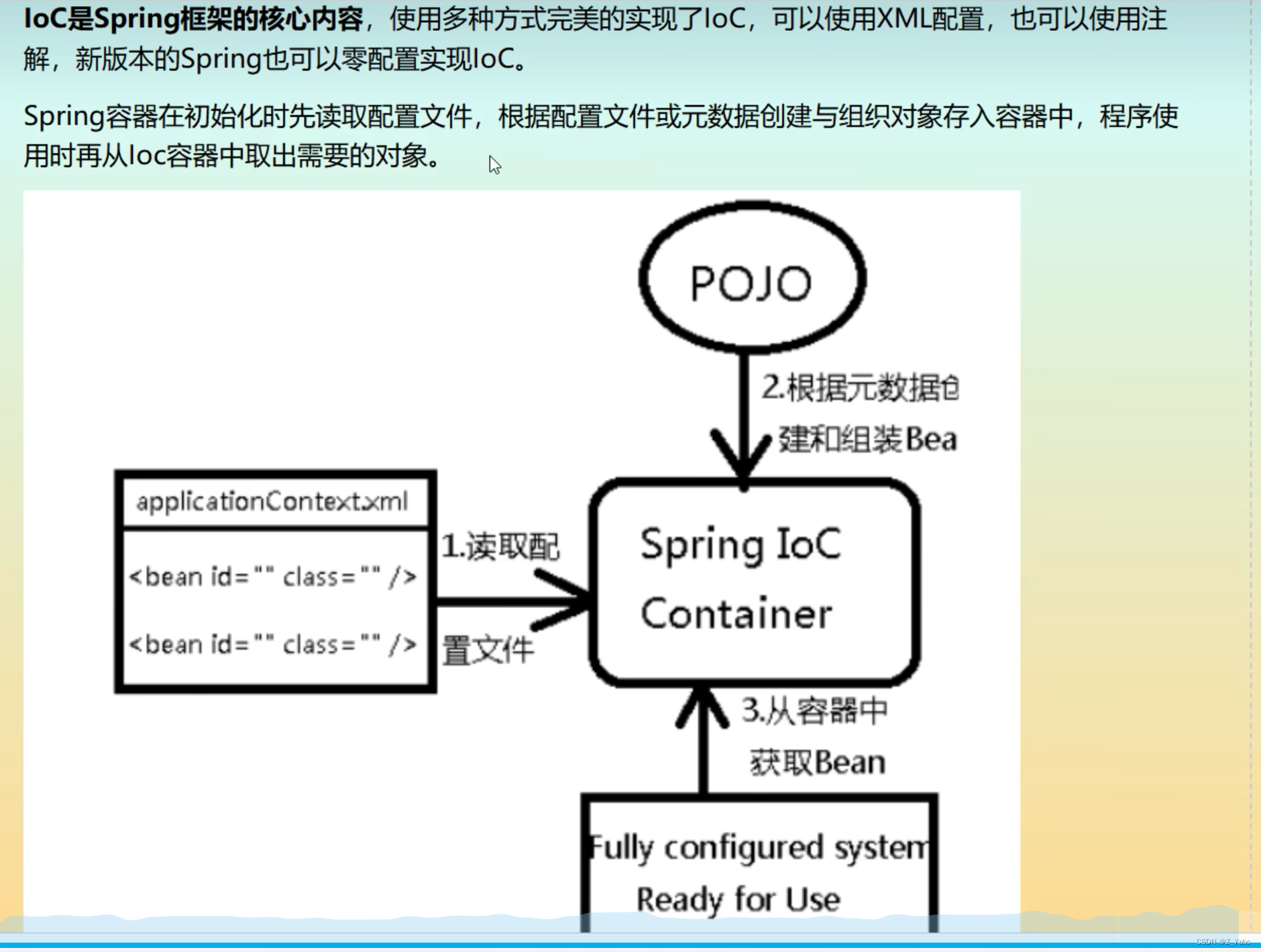
采用XML方式配置Bean的时候,Bean的定义信息是和实现分离的,而采用注解的方式可以把两者合为一体,Bean的定义信息直接以注解的形式定义在实现类中,从而达到了零配置的目的。
控制反转是一种通过描述(XML或注解)井通过第三方去生产或获取特定对象的方式。在Spring中实现控制反转的是IoC容器,其实现方法是依赖注入 (Dependency Injection,Dl)。
3.HelloSpring
思考:没有使用new,为什么会出来结果。
Hello.java
package com.zy.pojo;
public class Hello {
private String str;
public String getStr() {
return str;
}
public void setStr(String str) {
this.str = str;
}
@Override
public String toString() {
return "Hello{"+
"str='"+str+'\'' +
'}';
}
}
IDEA在导入spring以来后,可以自动生成applicationcontext文件,在resource右键new,XML Configuration File,Spring Config。
<?xml version="1.0" encoding="UTF-8"?>
<beans xmlns="http://www.springframework.org/schema/beans"
xmlns:xsi="http://www.w3.org/2001/XMLSchema-instance"
xsi:schemaLocation="http://www.springframework.org/schema/beans http://www.springframework.org/schema/beans/spring-beans.xsd">
<!--使用Spring来创建对象,在Spring这些都称为bean-->
<bean id="hello" class="com.zy.pojo.Hello">
<property name="str" value="Spring"/>
</bean>
</beans>
注意:若是提示没有找到spring中的哪个文件,那就是依赖的问题,可以在项目的文件结构里看看项目的依赖。
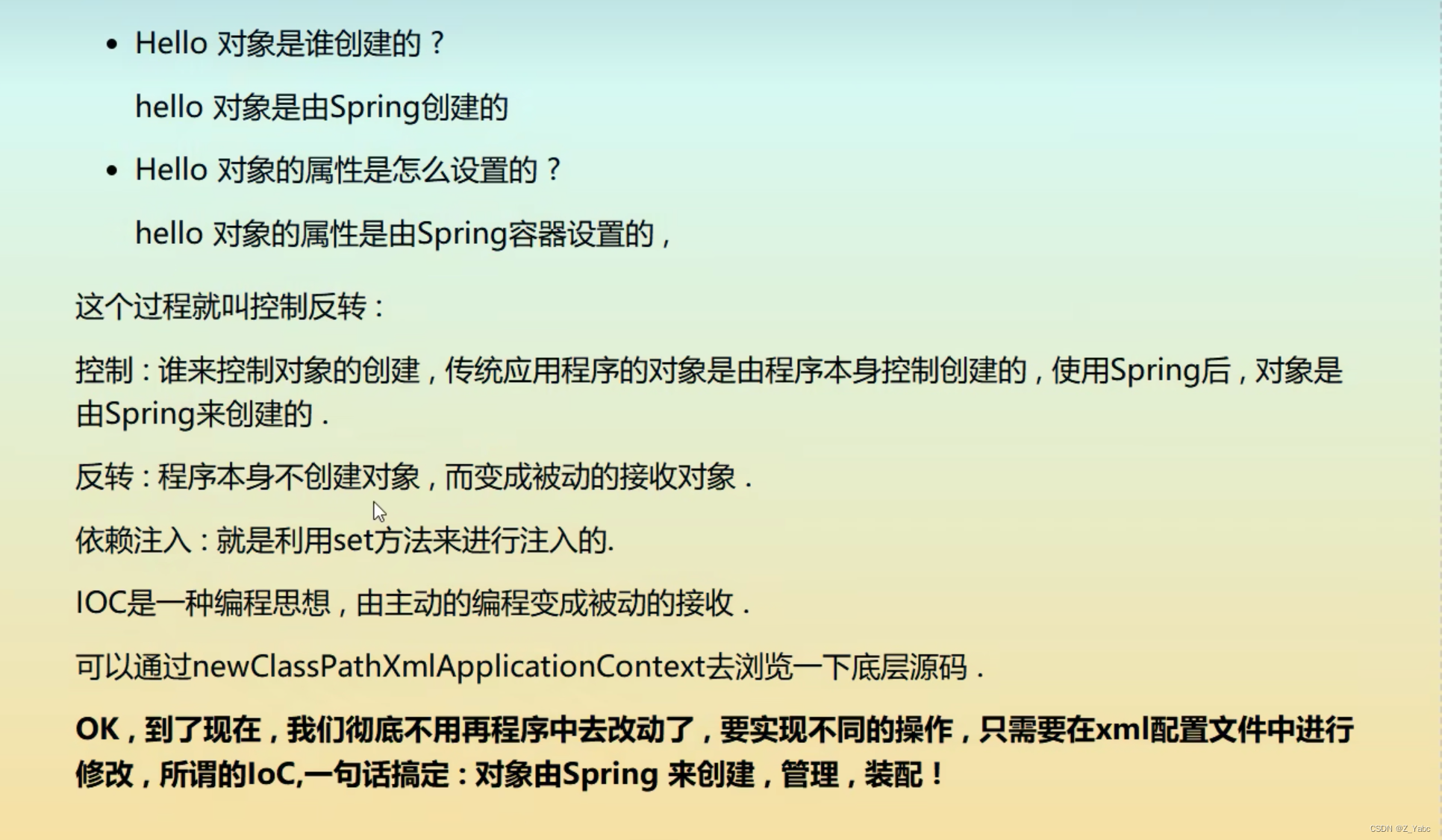
4. IoC创建对象的方式
- 使用无参构造创建对象。默认!
package com.zy.pojo;
public class User {
private String name;
public User(){
System.out.println("User的无参构造");
}
public String getName() {
return name;
}
public void setName(String name) {
this.name = name;
}
public void show() {
System.out.println("name=" + name);
}
}
<?xml version="1.0" encoding="UTF-8"?>
<beans xmlns="http://www.springframework.org/schema/beans"
xmlns:xsi="http://www.w3.org/2001/XMLSchema-instance"
xsi:schemaLocation="http://www.springframework.org/schema/beans http://www.springframework.org/schema/beans/spring-beans.xsd">
<bean id="user" class="com.zy.pojo.User">
<property name="name" value="zy"/>
</bean>
</beans>
- 假设我们要使用有参构造创建对象。
- 下标赋值
<bean id="user" class="com.zy.pojo.User">
<!--第一种创建对象的方式,下标赋值-->
<!--0表示构造方法中的第一个参数-->
<constructor-arg index="0" value="zy"/>
</bean>
2. 类型
<!--第二种方式:通过类型赋值,不建议使用-->
<bean id="user" class="com.zy.pojo.User">
<constructor-arg type="java.lang.String" value="zy"/>
</bean>
3. 参数名
<!--第三种,直接通过参数名来设置-->
<bean class="com.zy.pojo.User" id="user">
<constructor-arg name="name" value="zy"/>
</bean>
总结:在配置文件加载的时候,容器中管理的对象就已经初始化了!
5. Spring配置
5.1 别名
<!--别名,如果添加了别名,我们也可以使用别名获取这个对象-->
<alias name="user" alias="userNew"/>
5.2 Bean的配置
id:bean的唯一标识符,也就是相当于对象名
class:bean对象所对应的全限定名:包名+类名
name:也是别名,但是可以同时取多个别名。例如:name="user1,u1,u2 他们都指向同一个id
5.3 import
一般用于团队开发,它可以将多个配置文件导入合并为一个。
假设,现在项目中有多个人开发,这三个人负责不同的类开发,不同的类需要注册在不同的bean中,我们可以利用import将所有人的beans.xml合并为一个总的!
- 张三
- 李四
- 王五
- applicationContext.xmI
<import resource="beans.xml"/>
<import resource="beans2.xml"/>
<import resource="beans3.xml"/>
使用的时候,直接使用总的配置就可以了
6. 依赖注入
6.1 构造器注入
前面已经说过了
6.2 Set方式注入【重点】
- 依赖注入:set注入!
- 依赖:bean对象的创建依赖于容器
- 注入:bean对象中的所有属性,由容器来注入!
【环境搭建】
- 复杂类型
package com.zy.pojo;
public class Address {
private String address;
public String getAddress() {
return address;
}
public void setAddress(String address) {
this.address = address;
}
}
- 真是测试对象
package com.zy.pojo;
import java.util.List;
import java.util.Map;
import java.util.Properties;
import java.util.Set;
public class Student {
private String name;
private Address address;
private String[] books;
private List<String> hobbys;
private Map<String, String> card;
private Set<String> games;
private String wifi;
private Properties info;
public String getName() {
return name;
}
public void setName(String name) {
this.name = name;
}
public Address getAddress() {
return address;
}
public void setAddress(Address address) {
this.address = address;
}
public String[] getBooks() {
return books;
}
public void setBooks(String[] books) {
this.books = books;
}
public List<String> getHobbys() {
return hobbys;
}
public void setHobbys(List<String> hobbys) {
this.hobbys = hobbys;
}
public Map<String, String> getCard() {
return card;
}
public void setCard(Map<String, String> card) {
this.card = card;
}
public Set<String> getGames() {
return games;
}
public void setGames(Set<String> games) {
this.games = games;
}
public String getWifi() {
return wifi;
}
public void setWifi(String wifi) {
this.wifi = wifi;
}
public Properties getInfo() {
return info;
}
public void setInfo(Properties info) {
this.info = info;
}
@Override
public String toString() {
return super.toString();
}
}
- beans.xml
<?xml version="1.0" encoding="UTF-8"?>
<beans xmlns="http://www.springframework.org/schema/beans"
xmlns:xsi="http://www.w3.org/2001/XMLSchema-instance"
xsi:schemaLocation="http://www.springframework.org/schema/beans http://www.springframework.org/schema/beans/spring-beans.xsd">
<bean id="student" class="com.zy.pojo.Student">
<!--第一种,普通注入,value-->
<property name="name" value="zy"/>
</bean>
</beans>
- 测试类
import com.zy.pojo.Student;
import org.springframework.context.ApplicationContext;
import org.springframework.context.support.ClassPathXmlApplicationContext;
public class MyTest {
public static void main(String[] args) {
ApplicationContext context = new ClassPathXmlApplicationContext("beans.xml");
Student student = (Student) context.getBean("student");
System.out.println(student.getName());
}
}
完善注入信息
<?xml version="1.0" encoding="UTF-8"?>
<beans xmlns="http://www.springframework.org/schema/beans"
xmlns:xsi="http://www.w3.org/2001/XMLSchema-instance"
xsi:schemaLocation="http://www.springframework.org/schema/beans http://www.springframework.org/schema/beans/spring-beans.xsd">
<bean id="address" class="com.zy.pojo.Address">
<property name="address" value="西安"/>
</bean>
<bean id="student" class="com.zy.pojo.Student">
<!--第一种,普通注入,value-->
<property name="name" value="zy"/>
<!--第二种,Bean注入,引用类型使用ref-->
<property name="address" ref="address"/>
<!--数组注入-->
<property name="books">
<array>
<value>红楼梦</value>
<value>西游记</value>
<value>三国演义</value>
<value>水浒传</value>
</array>
</property>
<!--List注入-->
<property name="hobbys">
<list>
<value>听歌</value>
<value>敲代码</value>
<value>看电影</value>
</list>
</property>
<!--List注入,类似键值对-->
<property name="card">
<map>
<entry key="身份证" value="11111221323123123"/>
<entry key="银行卡" value="12313123123123123"/>
</map>
</property>
<!--Set-->
<property name="games">
<set>
<value>LOL</value>
<value>COC</value>
<value>BOB</value>
</set>
</property>
<!--null-->
<property name="wifi">
<null/>
</property>
<!--Properties-->
<property name="info">
<props>
<prop key="driver">201904</prop>
<prop key="url">nan</prop>
<prop key="username">root</prop>
<prop key="password">123456</prop>
</props>
</property>
</bean>
</beans>
6.3 扩展方式注入
6.3.1 c命名空间注入
给xml文件前面要加入xmlns:p=http://www.springframework.org/scheam/c
<?xml version="1.0" encoding="UTF-8"?>
<beans xmlns="http://www.springframework.org/schema/beans"
xmlns:xsi="http://www.w3.org/2001/XMLSchema-instance"
xmlns:c="http://www.springframework.org/schema/c"
xmlns:p="http://www.springframework.org/schema/p"
xsi:schemaLocation="http://www.springframework.org/schema/beans http://www.springframework.org/schema/beans/spring-beans.xsd">
<!--
c命名空间注入需要在类里添加有参构造
c命名空间注入,通过构造器注入:construct-args
-->
<bean id="user2" class="com.zy.pojo.User" c:age="18" c:name="zhaoyang"/>
</beans>
@Test
public void test2() {
ApplicationContext context = new ClassPathXmlApplicationContext("userbeans.xml");
User user = (User) context.getBean("user2");
System.out.println(user);
}
6.3.2 p命名空间注入
给xml文件前面要加入xmlns:p=http://www.springframework.org/scheam/p
<?xml version="1.0" encoding="UTF-8"?>
<beans xmlns="http://www.springframework.org/schema/beans"
xmlns:xsi="http://www.w3.org/2001/XMLSchema-instance"
xmlns:p="http://www.springframework.org/schema/p"
xsi:schemaLocation="http://www.springframework.org/schema/beans http://www.springframework.org/schema/beans/spring-beans.xsd">
<!--p命名空间注入,可以直接注入属性的值,property-->
<bean id="user" class="com.zy.pojo.User" p:name="zy" p:age="18"/>
</beans>
@Test
public void test2() {
ApplicationContext context = new ClassPathXmlApplicationContext("userbeans.xml");
User user = (User) context.getBean("user");
System.out.println(user);
}
}
package com.zy.pojo;
public class User {
private String name;
private int age;
public String getName() {
return name;
}
public void setName(String name) {
this.name = name;
}
public int getAge() {
return age;
}
public void setAge(int age) {
this.age = age;
}
@Override
public String toString() {
return "User{" +
"name='" + name + '\'' +
", age=" + age +
'}';
}
}
6.4 bean的作用域

- singleton:单例模式,只有一个实例,同一个id,默认
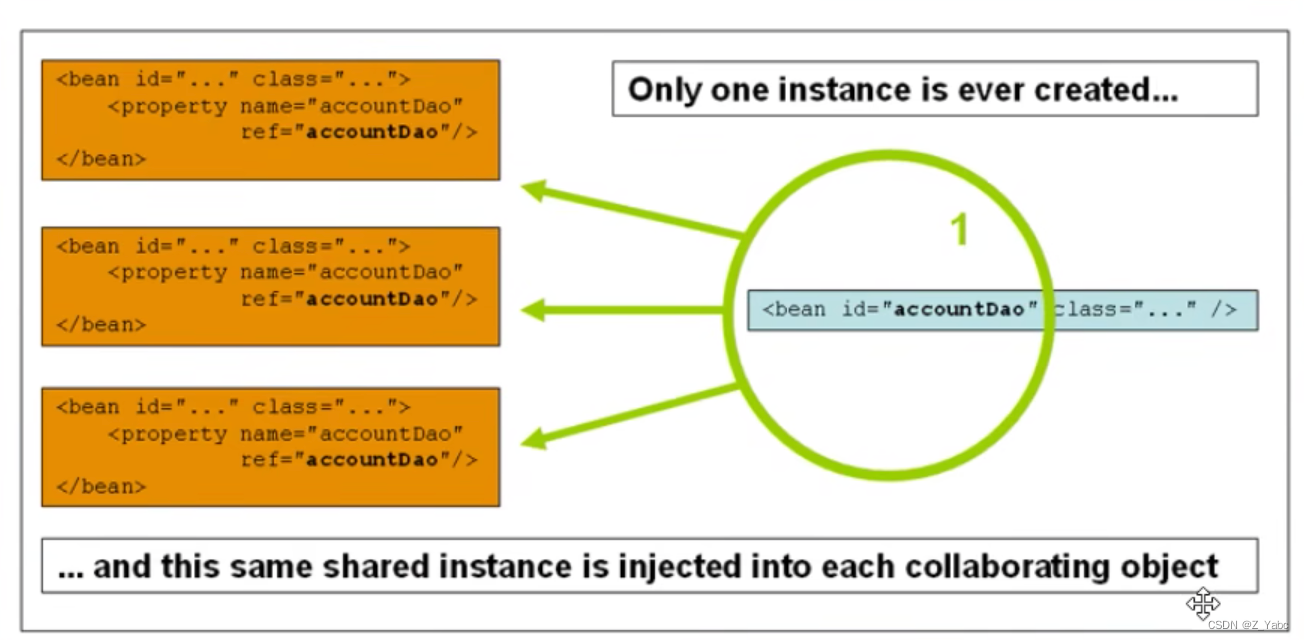
<bean id="user" class="com.zy.pojo.User" p:name="zy" p:age="18" scope="singleton"/>
- 原型模式:每次从容器中get的时候,都会产生一个新对象。
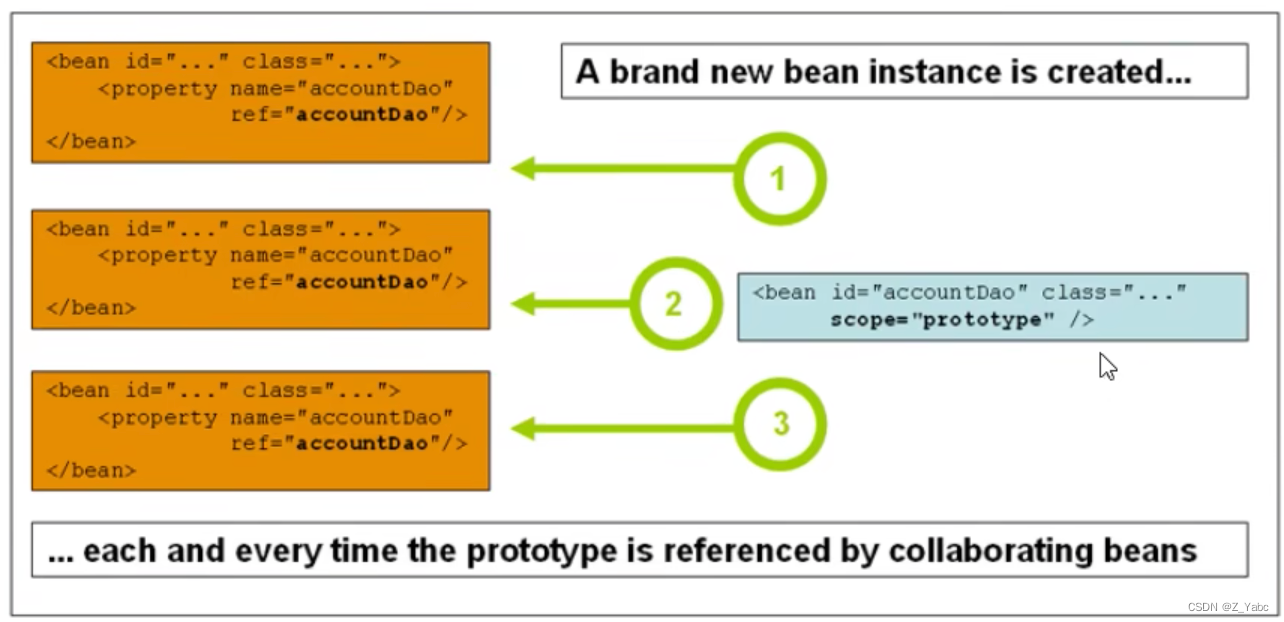
<bean id="user" class="com.zy.pojo.User" p:name="zy" p:age="18" scope="prototype"/>
- 其余的request、session、application这些只能在web开发中使用到。
7. Bean的自动装配
- 自动装配是Spring满足bean依赖的一种方式;
- Spring会在上下文中自动寻找bean,并自动给bean装配属性。
在Spring中有三种装配方式
- 在xml中显示的配置(上面提到的xml文件)
- 在Java中显示配置
- 隐式的自动装配
7.1 测试
- 一个人,两个宠物
<bean id="cat" class="com.zy.pojo.Cat"/>
<bean id="dag" class="com.zy.pojo.Dog"/>
<bean id="people" class="com.zy.pojo.People">
<property name="name" value="zhaoyang"/>
<!--引用类型用ref-->
<property name="cat" ref="cat"/>
<property name="dog" ref="dag"/>
</bean>
7.3 自动装配Autowire
<!--byName:会在容器上下文中查找,和自己对象set方法后面的值对应的bean id!-->
<bean id="people" class="com.zy.pojo.People" autowire="byName">
<property name="name" value="zhaoyang"/>
</bean>
<!--byType:会在容器上下文中查找,和自己对象属性类型相同的bean!要求就是类型得唯一,所以甚至不需要上面dog和cat的id-->
<bean id="people" class="com.zy.pojo.People" autowire="byType">
<property name="name" value="zhaoyang"/>
小结:
- byName的时候,需要保证所有bean的id唯一,并且这个bean需要和自动注入的属性的set方法的值一致!
- byType的时候,需要保证所有bean的class唯一,并且这个bean需要和自动注入的属性的类型一致!
7.4 使用注解实现自动装配
使用注解须知:
- 导入约束。context约束
- 配置注解的支持 context:annotation-config/
<?xml version="1.0" encoding="UTF-8"?>
<beans xmlns="http://www.springframework.org/schema/beans"
xmlns:xsi="http://www.w3.org/2001/XMLSchema-instance"
xmlns:context="http://www.springframework.org/schema/context"
xsi:schemaLocation="http://www.springframework.org/schema/beans
http://www.springframework.org/schema/beans/spring-beans.xsd
http://www.springframework.org/schema/context
http://www.springframework.org/schema/context/spring-context.xsd">
<context:annotation-config/>
</beans>
@Autowired
直接在属性上使用即可!也可以在set方法上使用!
有了注解可以连set方法都不需要写,前提是你这个自动装配的属性在IoC(Spring)容器中存在,且符合名字byName!
如果@Autowired自动装配的环境比较复杂,自动装配无法通过一个注解【@Autowired】完成的时候,我们可以使用@Quailifier(value=“xxx”)去配置@Autowired的使用,指定一个唯一的bean对象注入!
小结:
@Resource 和@ Autowired 的区别:
- 都是用来自动装配的,都可以放在属性字段上
- @ Autowired 通过byType的方式实现,而且必须要求这个对象存在!
【常用】 - @ Resource 默认通过byname的方式实现,如果找不到名字,则通过byType的方式实现。
项目开发小技巧,在note里记一些笔记和常用的内容。
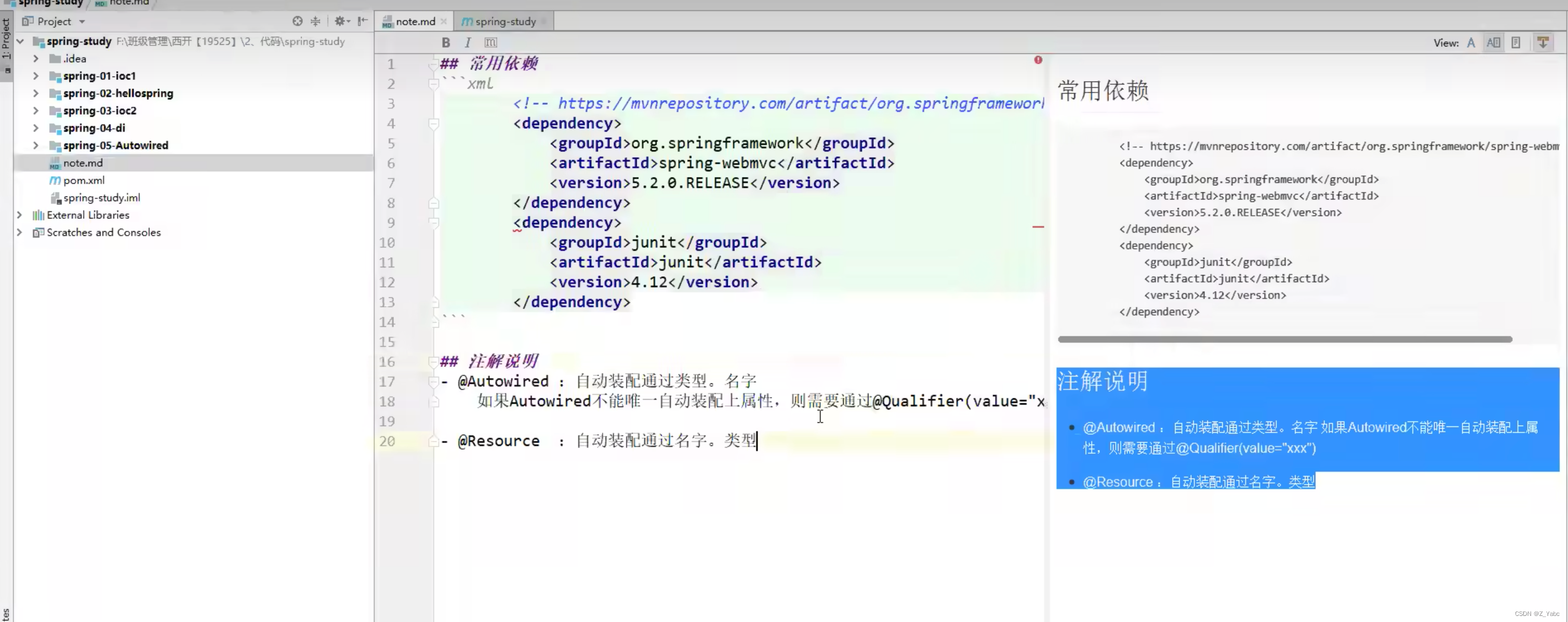
8. 使用注解开发
在Spring4之后,要使用注解开发,必须保证aop的包导入了

使用注解需要导入context约束,增加注解的支持!
- bean如何用注解实现
- 属性如何注入
package com.zy.pojo;
import org.springframework.beans.factory.annotation.Value;
import org.springframework.stereotype.Component;
//等价于<bean id="user" class="com.zy.pojo.User"/> component:组件
@Component
public class User {
//等价于<property name="name" value="zhaoyang"/>
@Value("zhaoyang")
public String name;
}
-
衍生的注解
@Component有几个衍生注解,在web开发中,会按照mvc三层架构分层!以下几个注解的功能和@Component一样,就是各层习惯用哪个注解- dao[@Repository]
- service[@Service]
- controller[Comtroller]
但是记着要在xml里添加自动扫描
这四个注解功能是一样的,都是代表将某个类注册到Spring中,装配Bean
-
自动装配
-
作用域
@Scope(“之前提到过的单例或者prototype”) -
小结
xml 与注解:
- xml更加万能,适用于任何场合!维护简单方便
- 注解 不是自己类使用不了,维护相对复杂!
xml 与注解最佳实践: - xml 用来管理bean;
- 注解只负责完成属性的注入;
- 我们在使用的过程中,只需要注意一个问题:必须让注解生效,就需要开启注解的支持
<!--指定要扫描的包,这个包下面的注解就会生效-->
<context:component-scan base-package="com.zy.pojo"/>
<context:annotation-config/>
9. 使用Java的方式配置Spring
我们现在完全不使用Spring的xml配置了,全权交给Java来做!
JavaConfig是Spring的一个子项目,在Spring4之后,它成为一个核心功能!
在一个类上加了@Configuration就类似于bean

实体类
package com.zy.pojo;
import org.springframework.beans.factory.annotation.Value;
import org.springframework.stereotype.Component;
import org.springframework.stereotype.Controller;
//这里这个注解的意思,就是说明这个累被Spring接管了,注册到容器中
@Component
public class User {
@Value("yuxin")
private String name;
public String getName() {
return name;
}
public void setName(String name) {
this.name = name;
}
@Override
public String toString() {
return "User{" +
"name='" + name + '\'' +
'}';
}
}
配置文件
package com.zy.config;
import com.zy.pojo.User;
import org.springframework.context.annotation.Bean;
import org.springframework.context.annotation.ComponentScan;
import org.springframework.context.annotation.Configuration;
import org.springframework.context.annotation.Import;
//这个也会被Spring容器托管,注册到容器中,因为进入到configuration它本身就是一个@Component
//@Configuration代表这是一个配置类,就和我们之前看的beans.xml一样
@Configuration
@ComponentScan("com.zy.pojo")
@Import(YuConfig2.class) //这样就把两个类引成一个类,也相当于导入
public class YuConfig {
//注册一个bean,就相当于我们之前写的一个bean标签
//这个方法的名字,就相当于bean标签中的id属性
//这个方法的返回值,就相当于bean标签中的class属性
@Bean
public User getUser() {
return new User(); //就是返回要注入到bean的对象!
}
}
测试类
import com.zy.config.YuConfig;
import com.zy.pojo.User;
import org.springframework.context.ApplicationContext;
import org.springframework.context.annotation.AnnotationConfigApplicationContext;
public class MyTest {
public static void main(String[] args) {
//如果使用了配置类的方法去做,就只能通过AnnotationConfig上下文来获取容器,通过配置累的class对象加载!
ApplicationContext context = new AnnotationConfigApplicationContext(YuConfig.class);
User getUser = (User) context.getBean("getUser");
System.out.println(getUser.getName());
}
}
这种纯Java的配置方式在SpringBoot中随处可见
10. AOP(面向切面编程)
为什么要学习代理模式?因为这就是SpringAOP的底层!
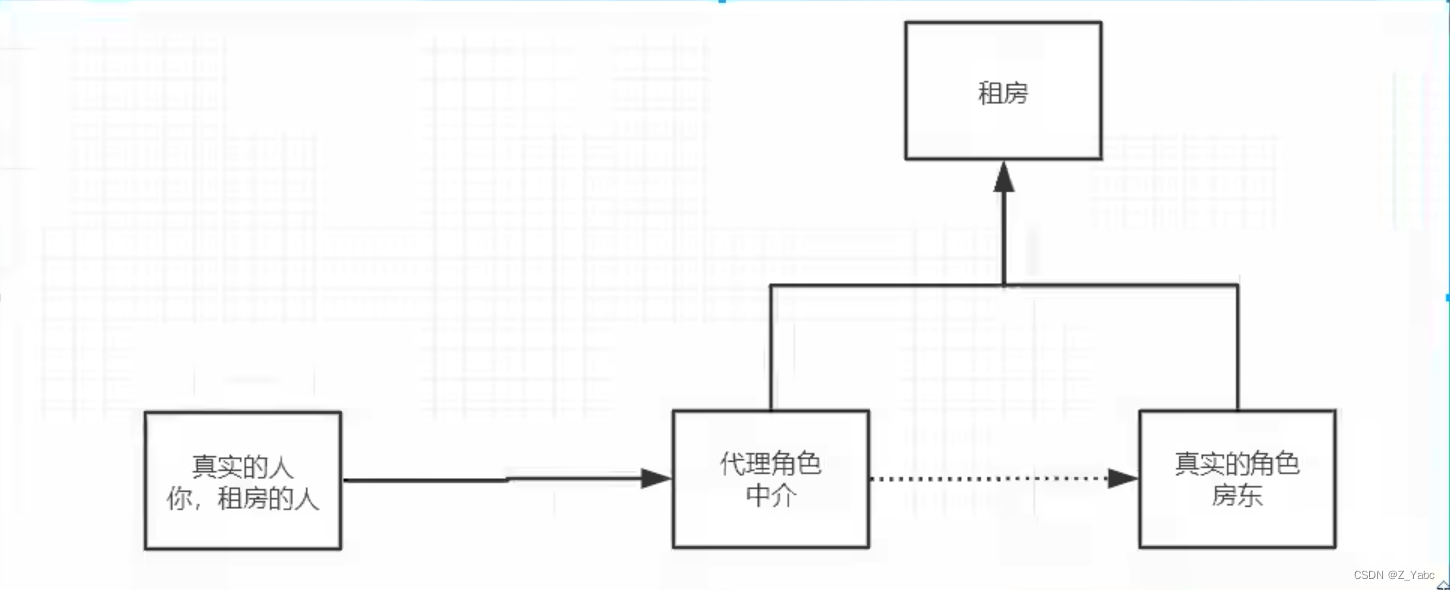
10.1 静态代理
角色分析:
- 抽象角色:一般会使用接口或者抽象类来解决
- 真实角色:被代理的角色
- 代理角色:代理真实角色,代理真实角色后,一般会做一下附属操作
- 客户:访问代理对象的人!
代码步骤
- 接口
package com.zy.demo01;
//租房
public interface Rent {
public void rent();
}
- 真实角色
package com.zy.demo01;
//房东
public class Host implements Rent{
@Override
public void rent() {
System.out.println("房东要出租房了");
}
}
- 代理角色
package com.zy.demo01;
//代理,租房的中介
public class Proxy implements Rent{
private Host host;
public Proxy() {
}
public Proxy(Host host) {
this.host = host;
}
@Override
public void rent() {
host.rent();
seeHouse();
heTong();
fare();
}
//看房
public void seeHouse() {
System.out.println("中介带你看房子");
}
//签合同
public void heTong() {
System.out.println("签租赁合同");
}
//收中介费
public void fare() {
System.out.println("收中介费");
}
}
- 客户端访问代理角色
package com.zy.demo01;
//租客租房
public class Client {
public static void main(String[] args) {
Host host = new Host();
//代理,中介帮房东租房子,但是,中介一般会有一些复数操作,比如签合同,看房,收中介费。
Proxy proxy = new Proxy(host);
//不用直接面对房东,直接找中介即可
proxy.rent();
}
}
代理模式的好处:
- 可以使真实角色的操作更加纯粹!不用去关注一些公共的业务
- 公共也就就交给代理角色!实现了业务的分工!
- 公共业务发生扩展的时候,方便集中管理!
缺点: - 一个真实角色就会产生一个代理角色;代码量会翻倍,开发效率会变低~
10.2 加深理解
接口
package com.zy.demo02;
public interface UserService {
public void add();
public void delete();
public void update();
public void query();
}
真实角色
package com.zy.demo02;
//真实对象
//这个就是纯粹的执行业务功能,要想增加一个打印日志,就是去代理文件里增加
public class UserServiceImpl implements UserService{
@Override
public void add() {
System.out.println("Add a user!");
}
@Override
public void delete() {
System.out.println("Delete a User!");
}
@Override
public void update() {
System.out.println("Update a user!");
}
@Override
public void query() {
System.out.println("Query a user!");
}
}
代理
package com.zy.demo02;
public class UserServiceProxy implements UserService{
//代理要代理真实角色,所以引入真实角色
private UserServiceImpl userService;
public void setUserService(UserServiceImpl userService) {
this.userService = userService;
} //引入
@Override
public void add() {
log("add");
userService.add();
}
@Override
public void delete() {
log("delete");
userService.delete();
}
@Override
public void update() {
log("update");
userService.update();
}
@Override
public void query() {
log("query");
userService.query();
}
//日志方法
public void log(String msg) {
System.out.println("使用了"+msg+"方法!");
}
}
用户
package com.zy.demo02;
public class Client {
public static void main(String[] args) {
UserServiceImpl userService = new UserServiceImpl();
//用户接下来就只用找代理去做了
UserServiceProxy proxy = new UserServiceProxy();
proxy.setUserService(userService); //启用代理,代理USI
proxy.add();
}
}

10.3 动态代理
- 动态代理和静态代理角色一样
- 动态代理的代理类是自动生成的,不是我们直接写的
- 动态代理分为两大类:基于接口的动态代理,基于类的动态代理
- 基于接口— JDK动态代理【这里使用】
- 基于类:cglib
- Java字节码实现:javasist
需要了解两个类:Proxy:代理,InvocationHandler:调用处理程序
这相当于万能的模版,修改红框里的类名

动态代理的好处:
- 可以使真实角色的操作更加纯粹,不用去关注一些公共的业务
- 公共的业务交给代理角色,实现了业务的分工
- 公共业务发生扩展的时候,方便集中管理
- 一个动态代理类代理的是一个接口,一般就是对应的一类业务
- 一个动态代理可以代理多个类,只要实现了同一个接口即可!
11. AOP
11.1 什么是AOP
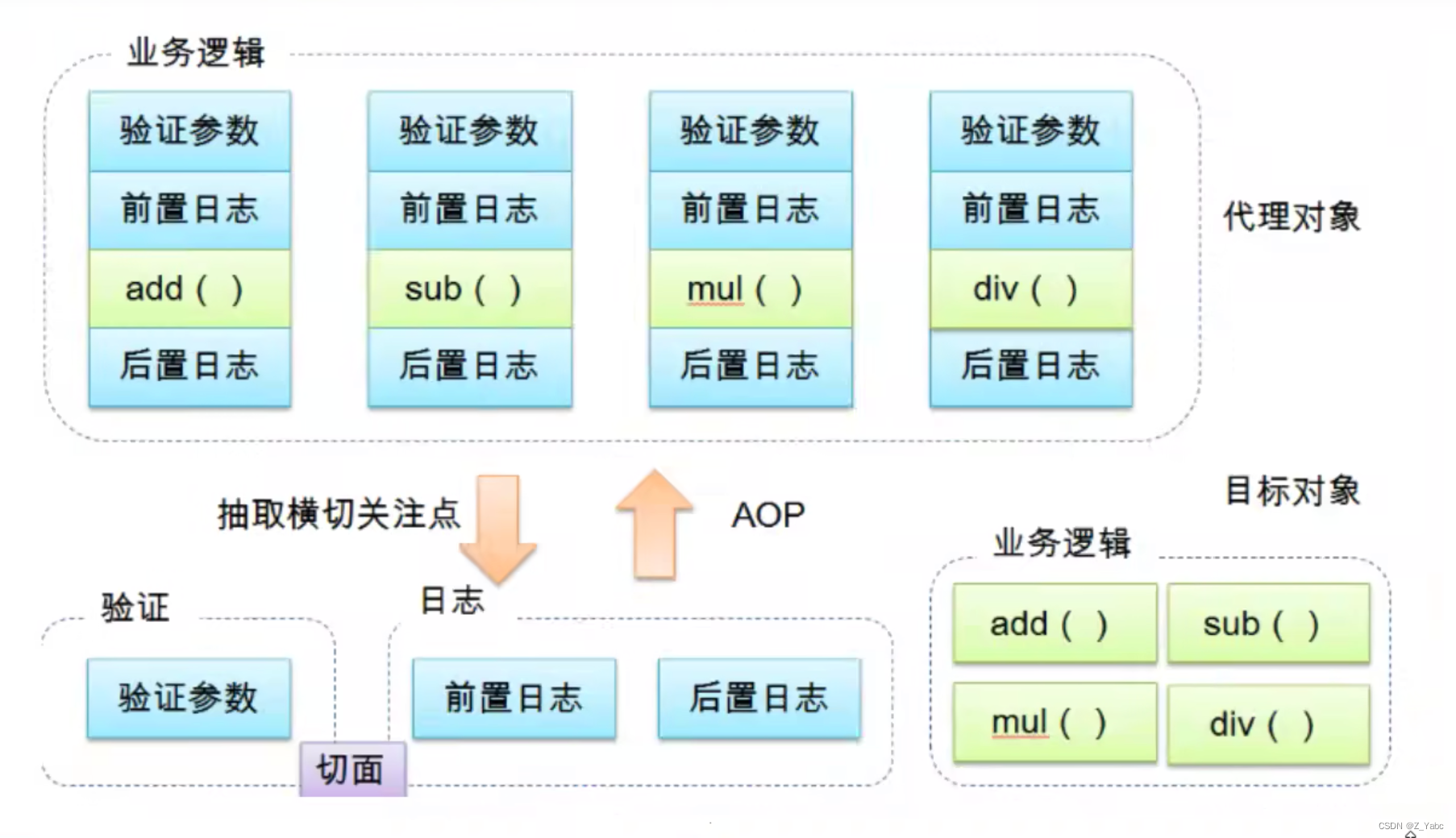
11.2 AOP在Spring中的作用
提供声明式事物,允许用户自定义切面。
- 横切关注点:跨越应用程序多个模块的方法或功能。即是,气我们业务逻辑无关的,但是我们需要关注的部分,就是横切关注点。如日志,安全,缓存,事务等等…
- 切面 (ASPECT):横切关注点 被模块化 的特殊对象。即,它是一个类。
- 通知 (Advice):切面必须要完成的工作。即,它是类中的一个方法。
- 目标 (Target):被通知对象。
- 代理 (Proxy):向目标对象应用通知之后创建的对象。
- 切入点 (PointCut):切面通知执行的“地点"的定义。
- 连接点 UointPoint):与切入点匹配的执行点。
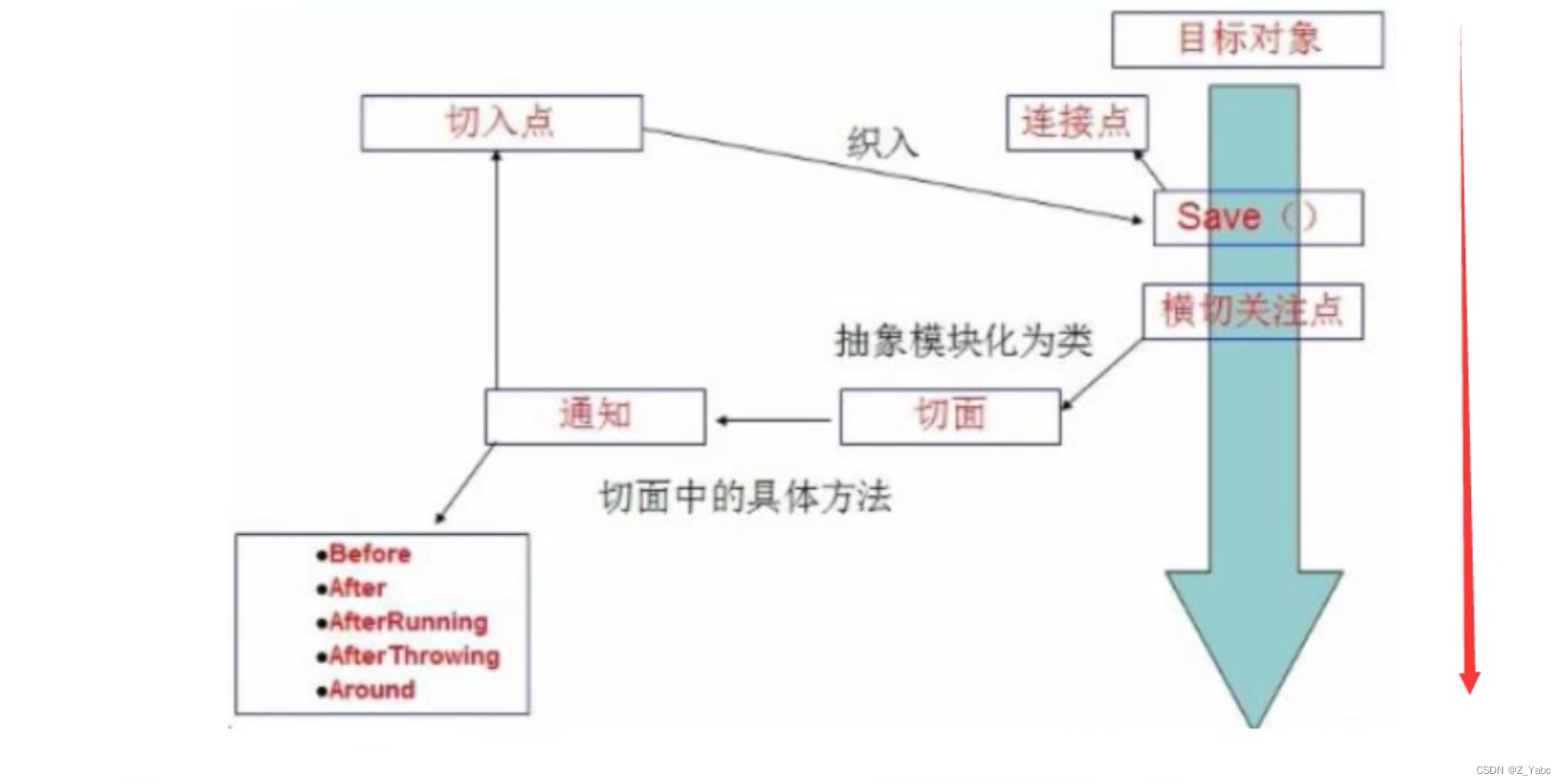
11.3 使用Spring实现AOP
使用AOP,需要导入一个依赖包
<!-- https://mvnrepository.com/artifact/org.aspectj/aspectjweaver -->
<dependency>
<groupId>org.aspectj</groupId>
<artifactId>aspectjweaver</artifactId>
<version>1.9.19</version>
<scope>runtime</scope>
</dependency>
方式一:使用Spring的API接口【主要是SpringAPI接口实现】
实现类
package com.zy.service;
public class UserServiceImpl implements UserService {
public void add() {
System.out.println("增加了一个用户");
}
public void delete() {
System.out.println("删除了一个用户");
}
public void update() {
System.out.println("更新了一个用户");
}
public void select() {
System.out.println("查询了一个用户");
}
}
日志作为切入
package com.zy.log;
import org.springframework.aop.MethodBeforeAdvice;
import java.lang.reflect.Method;
public class Log implements MethodBeforeAdvice {
//method:要执行的目标对象的方法
//args:参数
//target:目标对象
public void before(Method method, Object[] args, Object target) throws Throwable {
System.out.println(target.getClass().getName()+"的"+method.getName()+"被执行了");
}
}
package com.zy.log;
import org.springframework.aop.AfterReturningAdvice;
import java.lang.reflect.Method;
public class AfterLog implements AfterReturningAdvice {
//returnValue:返回值
public void afterReturning(Object returnValue, Method method, Object[] args, Object target) throws Throwable {
System.out.println("执行了"+method.getName()+"方法,返回结果为"+returnValue);
}
}
applicationContext.xml
<?xml version="1.0" encoding="UTF-8"?>
<beans xmlns="http://www.springframework.org/schema/beans"
xmlns:xsi="http://www.w3.org/2001/XMLSchema-instance"
xmlns:aop="http://www.springframework.org/schema/aop"
xsi:schemaLocation="http://www.springframework.org/schema/beans
http://www.springframework.org/schema/beans/spring-beans.xsd
http://www.springframework.org/schema/aop
http://www.springframework.org/schema/aop/spring-aop.xsd">
<!-- 注册bean-->
<bean id="userService" class="com.zy.service.UserServiceImpl"/>
<bean id="log" class="com.zy.log.Log"/>
<bean id="afterLog" class="com.zy.log.AfterLog"/>
<!-- 方式一;使用Spring API接口-->
<!-- 配置AOP:需要导入AOP的约束-->
<aop:config>
<!-- 切入点:expression表达式 expression(要执行的位置 * * * *)-->
<aop:pointcut id="pointcut" expression="execution(* com.zy.service.UserServiceImpl.*(..))"/>
<!-- 执行环绕增加-->
<!-- 将log这个类切入到pointcut这个切入点-->
<aop:advisor advice-ref="log" pointcut-ref="pointcut"/>
<aop:advisor advice-ref="afterLog" pointcut-ref="pointcut"/>
</aop:config>
</beans>
方式二:自定义类【主要是切面定义】
新加入一个要切入的类
package com.zy.diy;
public class DiyPointCut {
public void before() {
System.out.println("=======方法执行前======");
}
public void after() {
System.out.println("=======方法执行后======");
}
}
xml
<?xml version="1.0" encoding="UTF-8"?>
<beans xmlns="http://www.springframework.org/schema/beans"
xmlns:xsi="http://www.w3.org/2001/XMLSchema-instance"
xmlns:aop="http://www.springframework.org/schema/aop"
xsi:schemaLocation="http://www.springframework.org/schema/beans
http://www.springframework.org/schema/beans/spring-beans.xsd
http://www.springframework.org/schema/aop
http://www.springframework.org/schema/aop/spring-aop.xsd">
<!--注册bean-->
<bean id="userService" class="com.zy.service.UserServiceImpl"/>
<bean id="log" class="com.zy.log.Log"/>
<bean id="afterLog" class="com.zy.log.AfterLog"/>
<!--方式二:自定义类-->
<bean id="diy" class="com.zy.diy.DiyPointCut"/>
<aop:config>
<!--自定义切面,ref是要引用的类-->
<aop:aspect ref="diy">
<!--切入点-->
<aop:pointcut id="point" expression="execution(* com.zy.service.UserServiceImpl.*(..))"/>
<!--通知-->
<aop:before method="before" pointcut-ref="point"/>
<aop:after method="after" pointcut-ref="point"/>
</aop:aspect>
</aop:config>
</beans>
方式三:使用注解实现!
package com.zy.diy;
//方式三:使用注解实现AOP
import org.aspectj.lang.ProceedingJoinPoint;
import org.aspectj.lang.annotation.After;
import org.aspectj.lang.annotation.Around;
import org.aspectj.lang.annotation.Aspect;
import org.aspectj.lang.annotation.Before;
@Aspect
public class AnnotationPointCut {
@Before("execution(* com.zy.service.UserServiceImpl.*(..))")
public void before() {
System.out.println("=======方法执行前======");
}
@After("execution(* com.zy.service.UserServiceImpl.*(..))")
public void after() {
System.out.println("=======方法执行后======");
}
@Around("execution(* com.zy.service.UserServiceImpl.*(..))")
public void round(ProceedingJoinPoint jp) throws Throwable {
System.out.println("环绕前");
//执行方法
Object proceed = jp.proceed();
System.out.println("环绕后");
}
}
<!--方式三:使用注解-->
<bean id="annotationPointCut" class="com.zy.diy.AnnotationPointCut"/>
<!--开启注解支持-->
<aop:aspectj-autoproxy/>
12. 整合MyBatis
步骤:
- 导入相关jar包
- junit
- mybatis
- mysql数据库
- spring
- aop织入
- mybatis-spring
<dependency>
<groupId>junit</groupId>
<artifactId>junit</artifactId>
<version>4.13.2</version>
<scope>test</scope>
</dependency>
<dependency>
<groupId>mysql</groupId>
<artifactId>mysql-connector-java</artifactId>
<version>8.0.32</version>
</dependency>
<dependency>
<groupId>org.mybatis</groupId>
<artifactId>mybatis</artifactId>
<version>3.5.13</version>
</dependency>
<dependency>
<groupId>org.springframework</groupId>
<artifactId>spring-webmvc</artifactId>
<version>6.0.9</version>
</dependency>
<!--Spring操作数据库的话,需要一个spring-jdbc-->
<dependency>
<groupId>org.springframework</groupId>
<artifactId>spring-jdbc</artifactId>
<version>6.0.9</version>
</dependency>
<!--AOP织入包-->
<dependency>
<groupId>org.aspectj</groupId>
<artifactId>aspectjweaver</artifactId>
<version>1.9.19</version>
<scope>runtime</scope>
</dependency>
<!--mybatis整合包-->
<dependency>
<groupId>org.mybatis</groupId>
<artifactId>mybatis-spring</artifactId>
<version>3.0.2</version>
</dependency>
- 编写配置文件
- 测试
12.1 回忆mybatis
- 编写实体类
- 编写核心配置文件
- 编写接口
- 编写Mapper.xml
- 测试
详细看mybatis笔记
12.2 Mybatis-Spring
什么是mybatis-spring
mybatis-spring会帮助你将mybatis代码无缝的整合到spring中。
文档链接:http://mybatis.org/spring/zh/index.html
如果使用 Maven 作为构建工具,仅需要在 pom.xml 中加入以下代码即可:
<!-- https://mvnrepository.com/artifact/org.mybatis/mybatis-spring -->
<dependency>
<groupId>org.mybatis</groupId>
<artifactId>mybatis-spring</artifactId>
<version>2.0.2</version>
</dependency>
12.2.1 整合实现一:
- 引入spring配置文件spring-dao.xml
<?xml version="1.0" encoding="UTF-8"?>
<beans xmlns="http://www.springframework.org/schema/beans"
xmlns:xsi="http://www.w3.org/2001/XMLSchema-instance"
xsi:schemaLocation="http://www.springframework.org/schema/beans
http://www.springframework.org/schema/beans/spring-beans.xsd">
- 配置数据源替换mybatis的数据源
<?xml version="1.0" encoding="UTF-8"?>
<beans xmlns="http://www.springframework.org/schema/beans"
xmlns:xsi="http://www.w3.org/2001/XMLSchema-instance"
xsi:schemaLocation="http://www.springframework.org/schema/beans
http://www.springframework.org/schema/beans/spring-beans.xsd">
<!--DataSource:使用Spring的数据源替换Mybatis的配置 c3p0 dbcp druid
我们这里使用Spring提供的JDBC:org.springframework.jdbc.datasource
-->
<bean id="dataSource" class="org.springframework.jdbc.datasource.DriverManagerDataSource">
<property name="driverClassName" value="com.mysql.cj.jdbc.Driver"/>
<property name="url"
value="jdbc:mysql://localhost:3306/mybatis?useSSL=true&useUnicode=true&characterEncoding=UTF-8"/>
<property name="username" value="root"/>
<property name="password" value="123456"/>
</bean>
- 配置SQLSessionFactory,关联mybatis
<!--配置SQLSessionFactory,关联mybatis-->
<!--配置SQLSessionFactory-->
<bean id="sqlSessionFactory" class="org.mybatis.spring.SqlSessionFactoryBean">
<property name="dataSource" ref="dataSource"/>
<!--绑定Mybatis配置文件-->
<property name="configLocation" value="classpath:mybatis-config.xml"/>
<property name="mapperLocations" value="classpath:com/zy/mapper/*xml"/>
</bean>
- 注册sqlsessionTemplate,关联SQLSessionFactory
<!--注册sqlsessionTemplate,关联SQLSessionFactory-->
<!--SqlSessionTemplate:就是我们使用的sqlSession-->
<bean id="sqlSession" class="org.mybatis.spring.SqlSessionTemplate">
<constructor-arg index="0" ref="sqlSessionFactory"/>
</bean>
- 需要UserMapper接口的UserMapperImpl实现类,私有化sqlsessionTemplate,实现类就干这一件事情
public class UserMapperImpl implements UserMapper{
//所有的操作,在原来,都是用sqlSession来执行,现在我们都使用sqlSessionTemplate;
private SqlSessionTemplate sqlSession;
public void setSqlSession(SqlSessionTemplate sqlSession) {
this.sqlSession = sqlSession;
}
@Override
public List<User> selectUser() {
UserMapper mapper = sqlSession.getMapper(UserMapper.class);
return mapper.selectUser();
}
}
- 将自己写的实现类,注入的spring配置中
<bean id="userMapper" class="com.zy.mapper.UserMapperImpl">
<property name="sqlSession" ref="sqlSession"/>
</bean>
- 测试使用即可!
@Test
public void selectUser() {
ClassPathXmlApplicationContext context = new ClassPathXmlApplicationContext("spring-dao.xml");
UserMapper userMapper = context.getBean("userMapper", UserMapper.class);
for (User user : userMapper.selectUser()) {
System.out.println(user);
}
}
可以使用applicationContext.xml,导入spring-dao.xml,这就可以更方便的整合。
12.2.2 整合实现二

将我们上面写的UserMapperImpl修改一下
public class UserMapperImpl2 extends SqlSessionDaoSupport implements UserMapper{
@Override
public List<User> selectUser() {
SqlSession sqlSession = getSqlSession();
UserMapper mapper = sqlSession.getMapper(UserMapper.class);
return mapper.selectUser();
}
}
注入到Spring配置文件中。
<bean id="userMapper2" class="com.zy.mapper.UserMapperImpl2">
<property name="sqlSessionFactory" ref="sqlSessionFactory"/>
</bean>
测试
@Test
public void selectUser() {
ClassPathXmlApplicationContext context = new ClassPathXmlApplicationContext("spring-dao.xml");
UserMapper userMapper = context.getBean("userMapper2", UserMapper.class);
for (User user : userMapper.selectUser()) {
System.out.println(user);
}
}
13 声明式事务
13.1 回顾事务
- 把一组业务当作一个业务来做,要么都成功,要么都失败!
- 事务在项目开发中十分重要,涉及到数据的一致性问题,不能马虎!
- 确保完整性和一致性!
事务的ACID原则:
- 原子性:
- 事务是原子性操作,要么同时全部完成,要么完全不起作用。
- 一致性:
- 一旦所有事务动作完成,事务就要被提交,数据和资源处于一种满足业务规格的一致性状态
- 事务提交前和提交后,数据的完整性不变
- 隔离性:
- 多个事务同时处理相同的数据,每个事务都应该与其他事务隔离开来,防止数据损坏
- 持久性
- 事务一旦完成,无论系统发生什么错误,结果都不会收到影响,通常情况下,事务一旦被提交,就会被持久化到数据库中。
测试:
将上面的代码拷贝到一个新项目中
在之前的案例中,我们给userMapper接口新增两个方法,删除和增加用户;
//添加一个用户
public int addUser(User user);
//删除一个用户
public int deleteUser(int id);
UserMapper文件,我们故意把 deletes 写错,测试!
<insert id="addUser" parameterType="user">
insert into mybatis.user(id, name, pwd)
values (#{id},#{name},#{pwd});
</insert>
<delete id="deleteUser" parameterType="int">
deletes from mybatis.user
where id=#{id};
</delete>
编写接口的UserMapperImpl实现类,在实现类中,我们去操作一波
public class UserMapperImpl extends SqlSessionDaoSupport implements UserMapper{
@Override
public List<User> selectUser() {
User user = new User(5, "小王", "123456");
SqlSession sqlSession = getSqlSession();
UserMapper mapper = sqlSession.getMapper(UserMapper.class);
mapper.addUser(user);
mapper.deleteUser(5);
return mapper.selectUser();
}
测试
@Test
public void selectUser() {
ClassPathXmlApplicationContext context = new ClassPathXmlApplicationContext("applicationContext.xml");
UserMapper userMapper = context.getBean("userMapper", UserMapper.class);
for (User user : userMapper.selectUser()) {
System.out.println(user);
}
}
报错:sql异常,delete写错了
结果 :数据库结果显示插入成功!
没有进行事务的管理;我们想让他们都成功才成功,有一个失败,就都失败,我们就应该需要事务!
以前我们都需要自己手动管理事务,十分麻烦!
但是Spring给我们提供了事务管理,我们只需要配置即可;
13.2 Spring中的事务管理
spring在不同的事务管理API之上定义了一个抽象层,是的开发人员不必了解底层的事务管理API就可以使用spring的事务管理机制。spring支持编程式事务管理和声明式的事务管理
编程式事务管理
-
将事务管理代码嵌入到业务方法中来控制事务的提交和回滚
-
缺点:必须在每个事务的操作业务逻辑中包含额外的事务管理代码
声明式事务管理 -
一般情况下比编程式事务管理好用
-
将事务管理代码从业务方法中分离出来,以声明的方式来实现事务管理
-
将事务管理作为横切关注点,通过aop方法模块化。spring中通过spring aop框架支持声明式事务管理
- 使用spring管理实务,注意头文件的约束导入:tx
<?xml version="1.0" encoding="UTF-8"?>
<beans xmlns="http://www.springframework.org/schema/beans"
xmlns:xsi="http://www.w3.org/2001/XMLSchema-instance"
xmlns:aop="http://www.springframework.org/schema/aop"
xmlns:tx="http://www.springframework.org/schema/tx"
xsi:schemaLocation="http://www.springframework.org/schema/beans
http://www.springframework.org/schema/beans/spring-beans.xsd
http://www.springframework.org/schema/aop
http://www.springframework.org/schema/aop/spring-aop.xsd
http://www.springframework.org/schema/tx
http://www.springframework.org/schema/tx/spring-tx.xsd">
- JDBC事务
<!--配置声明式事务-->
<bean id="transactionManager" class="org.springframework.jdbc.datasource.DataSourceTransactionManager">
<property name="dataSource" ref="dataSource"/>
</bean>
- 配置好事务管理器后,我们需要去配置事务的通知
<!--结合AOP,实现事务的织入-->
<!--配置事务通知-->
<tx:advice id="txAdvice" transaction-manager="transactionManager">
<!--给那些方法配置事务-->
<!--配置事务的传播特性:new propagation-->
<tx:attributes>
<tx:method name="add" propagation="REQUIRED"/>
<tx:method name="delect" propagation="REQUIRED"/>
<tx:method name="update" propagation="REQUIRED"/>
<tx:method name="query" read-only="true"/>
<tx:method name="*" propagation="REQUIRED"/>
</tx:attributes>
</tx:advice>
- 配置AOP,导入aop的头文件
<!--配置事务切入-->
<aop:config>
<aop:pointcut id="txPointCut" expression="execution(* com.zy.mapper.*.*(..))"/>
<aop:advisor advice-ref="txAdvice" pointcut-ref="txPointCut"/>
</aop:config>
spring事务传播特性:
事务传播行为就是多个事务方法相互调用的时候,事务如何在这些方法间传播。spring支持7中事务传播行为:
- propagation_requierd:如果没有当前事务,就新建一个事务,如果已存在一个事务中,加入这个事务;
- propagation_support:支持当前事务,如果没有当前事务,就以非事务方法执行
- propagation_mandatory:支持当前事务,如果没有当前事务就抛出异常
- propagation_requierd_new:不支持当前事务,新建事务,如果当前存在任务,就把当前任务挂起。
- propagation_not_supported:以非事务方式执行操作,如果当前存在事务,就把当前事务挂起。
- propagation_never:以非事务方式执行,如果当前存在事务,就抛出异常
- propagation_nested:如果当前存在事务,就在嵌套事务内执行,如果当前没有事务,则执行与propagation_required类似的操作。
- spring默认的事务传播行为是;propagation_required,它适用于绝大多数的情况。
就好比,我们刚才的几个方法存在调用,所以会被放在一组事务中。
- 删掉刚才插入的数据,再次测试
@Test
public void selectUser() {
ClassPathXmlApplicationContext context = new ClassPathXmlApplicationContext("applicationContext.xml");
UserMapper userMapper = context.getBean("userMapper", UserMapper.class);
for (User user : userMapper.selectUser()) {
System.out.println(user);
}
}
这次直接报错,也不会只有插入成功而删除不成功的现象。
13.3 思考:
为什么需要事务?
- 如果不配置事务,可能存在数据提交不一致的情况;
- 如果我们不在spring中配置声明式事务,我们就需要在代码中手动配置事务
- 事务在项目开发中十分重要,涉及到数据的一致性和完整性的问题。






















 8万+
8万+











 被折叠的 条评论
为什么被折叠?
被折叠的 条评论
为什么被折叠?








